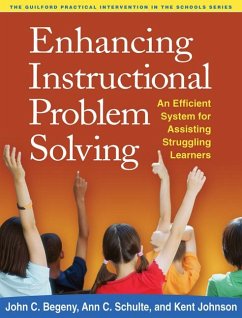John C Begeny, Ann C Schulte, Kent Johnson
Enhancing Instructional Problem Solving
An Efficient System for Assisting Struggling Learners
John C Begeny, Ann C Schulte, Kent Johnson
Enhancing Instructional Problem Solving
An Efficient System for Assisting Struggling Learners
- Broschiertes Buch
- Merkliste
- Auf die Merkliste
- Bewerten Bewerten
- Teilen
- Produkt teilen
- Produkterinnerung
- Produkterinnerung
This book presents a schoolwide model of instructional support designed to make the most of available time, resources, and personnel-one that is also fully compatible with other problem-solving models, such as response to intervention.
Andere Kunden interessierten sich auch für
![The Power of Peers in the Classroom The Power of Peers in the Classroom]() The Power of Peers in the Classroom48,99 €
The Power of Peers in the Classroom48,99 €![Practical Handbook of Multi-Tiered Systems of Support Practical Handbook of Multi-Tiered Systems of Support]() Rachel Brown-ChidseyPractical Handbook of Multi-Tiered Systems of Support52,99 €
Rachel Brown-ChidseyPractical Handbook of Multi-Tiered Systems of Support52,99 €![Essentials of Intensive Intervention Essentials of Intensive Intervention]() Essentials of Intensive Intervention42,99 €
Essentials of Intensive Intervention42,99 €![Teaching Anger Management and Problem-Solving Skills for 9-12 Year Olds Teaching Anger Management and Problem-Solving Skills for 9-12 Year Olds]() Tina RaeTeaching Anger Management and Problem-Solving Skills for 9-12 Year Olds68,99 €
Tina RaeTeaching Anger Management and Problem-Solving Skills for 9-12 Year Olds68,99 €![Developing a Schoolwide Framework to Prevent and Manage Learning and Behavior Problems Developing a Schoolwide Framework to Prevent and Manage Learning and Behavior Problems]() Kathleen Lynne LaneDeveloping a Schoolwide Framework to Prevent and Manage Learning and Behavior Problems48,99 €
Kathleen Lynne LaneDeveloping a Schoolwide Framework to Prevent and Manage Learning and Behavior Problems48,99 €![Homework Success for Children with ADHD Homework Success for Children with ADHD]() Thomas J PowerHomework Success for Children with ADHD48,99 €
Thomas J PowerHomework Success for Children with ADHD48,99 €![Instructional Practices for Students with Behavioral Disorders Instructional Practices for Students with Behavioral Disorders]() J Ron NelsonInstructional Practices for Students with Behavioral Disorders38,99 €
J Ron NelsonInstructional Practices for Students with Behavioral Disorders38,99 €-
-
-
This book presents a schoolwide model of instructional support designed to make the most of available time, resources, and personnel-one that is also fully compatible with other problem-solving models, such as response to intervention.
Hinweis: Dieser Artikel kann nur an eine deutsche Lieferadresse ausgeliefert werden.
Hinweis: Dieser Artikel kann nur an eine deutsche Lieferadresse ausgeliefert werden.
Produktdetails
- Produktdetails
- Verlag: Guilford Publications
- Seitenzahl: 336
- Altersempfehlung: 5 bis 13 Jahre
- Erscheinungstermin: 9. Mai 2012
- Englisch
- Abmessung: 267mm x 204mm x 20mm
- Gewicht: 735g
- ISBN-13: 9781462504770
- ISBN-10: 1462504779
- Artikelnr.: 34668438
- Herstellerkennzeichnung
- Libri GmbH
- Europaallee 1
- 36244 Bad Hersfeld
- gpsr@libri.de
- Verlag: Guilford Publications
- Seitenzahl: 336
- Altersempfehlung: 5 bis 13 Jahre
- Erscheinungstermin: 9. Mai 2012
- Englisch
- Abmessung: 267mm x 204mm x 20mm
- Gewicht: 735g
- ISBN-13: 9781462504770
- ISBN-10: 1462504779
- Artikelnr.: 34668438
- Herstellerkennzeichnung
- Libri GmbH
- Europaallee 1
- 36244 Bad Hersfeld
- gpsr@libri.de
John C. Begeny, PhD, is Associate Professor in the School Psychology Program at North Carolina State University and a psychologist in North Carolina. He was awarded the Ernest A. Lynton Citation for Distinguished Engaged Scholarship. Dr. Begeny's research interests include academic consultation, methods to improve children's reading abilities, international education, and strategies to narrow the gap between research and practice in education. Ann C. Schulte, PhD, is Professor in the Department of Psychology at North Carolina State University. She serves on the editorial boards of multiple journals, including Journal of School Psychology, School Psychology Review, and Learning Disabilities Research & Practice. Dr. Schulte's research focuses on school-based services for children with disabilities and improvement of achievement outcomes for this population. Kent Johnson, PhD, is Founder and Executive Director of Morningside Academy, a laboratory school in Seattle, Washington. Morningside Academy investigates effective curriculum materials and teaching methods, and has provided training and consulting in instruction to over 125 schools and agencies in the United States and Canada. Dr. Johnson has published many articles and books on research-based curriculum and teaching methods.
I. Preparing for Implementation 1. Introduction to the Systems-Oriented
Plan for Academic Achievement 2. SOPAA Key Definitions, History,
Components, and Roles 3. Preliminary Considerations for SOPAA
Implementation II. The Six SOPAA Components 4. Initial Steps of the TAPS
Process: Requests for Academic Support and Preparation for the Intervention
Planning Meeting 5. Secondary Steps of the TAPS Process: Intervention
Planning, Follow-Ups, and Summative Reviews of Intervention Effectiveness
6. Assessment for Instruction 7. Maximizing Implementation through Targeted
Professional Development 8. Maximizing Intervention Delivery through
Recruiting and Training School Volunteers 9. Obtaining Support for the
SOPAA through Effective Communication with School Leaders 10. Obtaining and
Sustaining Support for the SOPAA through Effective Communication with
Teachers 11. Using the SOPAA with Multidisciplinary Co-Facilitators III.
Additional Information and Guidance 12. Evidence-Based and Learner-Verified
Intervention Programs in Reading, Mathematics, and Writing 13. Case
Illustrations of SOPAA Implementation 14. Using the SOPAA to Support
Graduate Students' Training and Applied Experiences in Schools Epilogue
Appendices
Plan for Academic Achievement 2. SOPAA Key Definitions, History,
Components, and Roles 3. Preliminary Considerations for SOPAA
Implementation II. The Six SOPAA Components 4. Initial Steps of the TAPS
Process: Requests for Academic Support and Preparation for the Intervention
Planning Meeting 5. Secondary Steps of the TAPS Process: Intervention
Planning, Follow-Ups, and Summative Reviews of Intervention Effectiveness
6. Assessment for Instruction 7. Maximizing Implementation through Targeted
Professional Development 8. Maximizing Intervention Delivery through
Recruiting and Training School Volunteers 9. Obtaining Support for the
SOPAA through Effective Communication with School Leaders 10. Obtaining and
Sustaining Support for the SOPAA through Effective Communication with
Teachers 11. Using the SOPAA with Multidisciplinary Co-Facilitators III.
Additional Information and Guidance 12. Evidence-Based and Learner-Verified
Intervention Programs in Reading, Mathematics, and Writing 13. Case
Illustrations of SOPAA Implementation 14. Using the SOPAA to Support
Graduate Students' Training and Applied Experiences in Schools Epilogue
Appendices
I. Preparing for Implementation 1. Introduction to the Systems-Oriented
Plan for Academic Achievement 2. SOPAA Key Definitions, History,
Components, and Roles 3. Preliminary Considerations for SOPAA
Implementation II. The Six SOPAA Components 4. Initial Steps of the TAPS
Process: Requests for Academic Support and Preparation for the Intervention
Planning Meeting 5. Secondary Steps of the TAPS Process: Intervention
Planning, Follow-Ups, and Summative Reviews of Intervention Effectiveness
6. Assessment for Instruction 7. Maximizing Implementation through Targeted
Professional Development 8. Maximizing Intervention Delivery through
Recruiting and Training School Volunteers 9. Obtaining Support for the
SOPAA through Effective Communication with School Leaders 10. Obtaining and
Sustaining Support for the SOPAA through Effective Communication with
Teachers 11. Using the SOPAA with Multidisciplinary Co-Facilitators III.
Additional Information and Guidance 12. Evidence-Based and Learner-Verified
Intervention Programs in Reading, Mathematics, and Writing 13. Case
Illustrations of SOPAA Implementation 14. Using the SOPAA to Support
Graduate Students' Training and Applied Experiences in Schools Epilogue
Appendices
Plan for Academic Achievement 2. SOPAA Key Definitions, History,
Components, and Roles 3. Preliminary Considerations for SOPAA
Implementation II. The Six SOPAA Components 4. Initial Steps of the TAPS
Process: Requests for Academic Support and Preparation for the Intervention
Planning Meeting 5. Secondary Steps of the TAPS Process: Intervention
Planning, Follow-Ups, and Summative Reviews of Intervention Effectiveness
6. Assessment for Instruction 7. Maximizing Implementation through Targeted
Professional Development 8. Maximizing Intervention Delivery through
Recruiting and Training School Volunteers 9. Obtaining Support for the
SOPAA through Effective Communication with School Leaders 10. Obtaining and
Sustaining Support for the SOPAA through Effective Communication with
Teachers 11. Using the SOPAA with Multidisciplinary Co-Facilitators III.
Additional Information and Guidance 12. Evidence-Based and Learner-Verified
Intervention Programs in Reading, Mathematics, and Writing 13. Case
Illustrations of SOPAA Implementation 14. Using the SOPAA to Support
Graduate Students' Training and Applied Experiences in Schools Epilogue
Appendices








